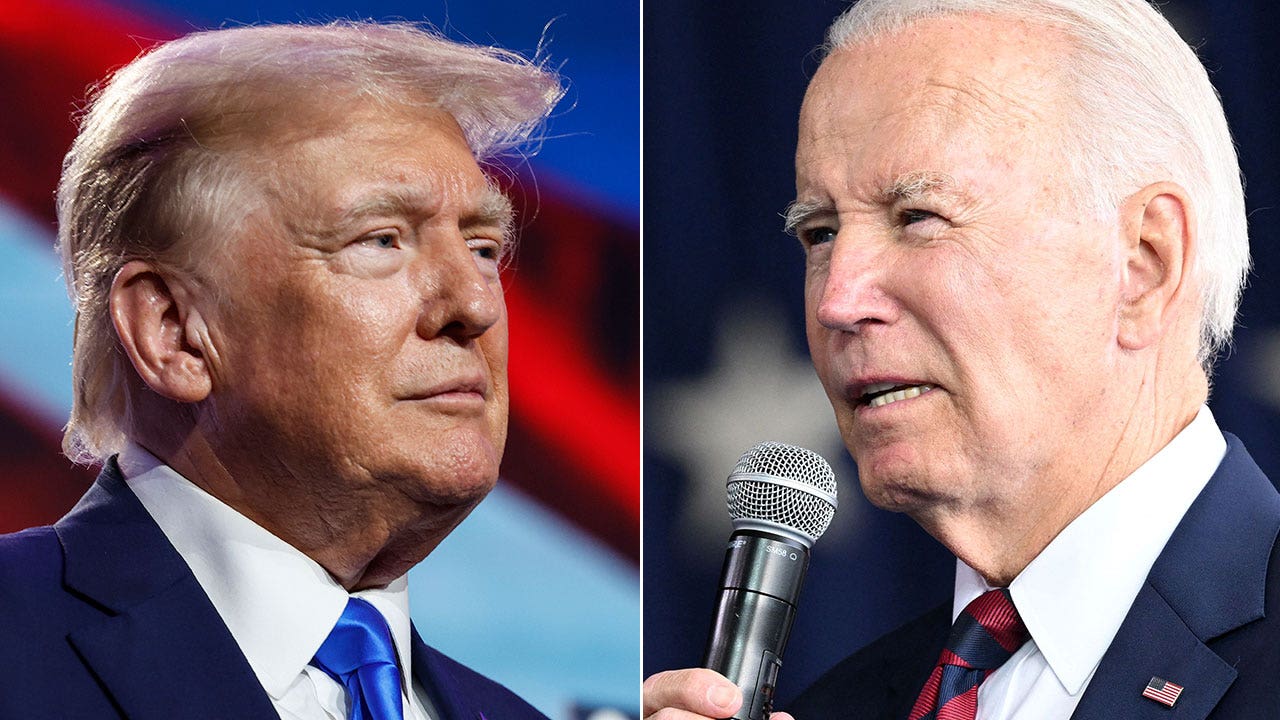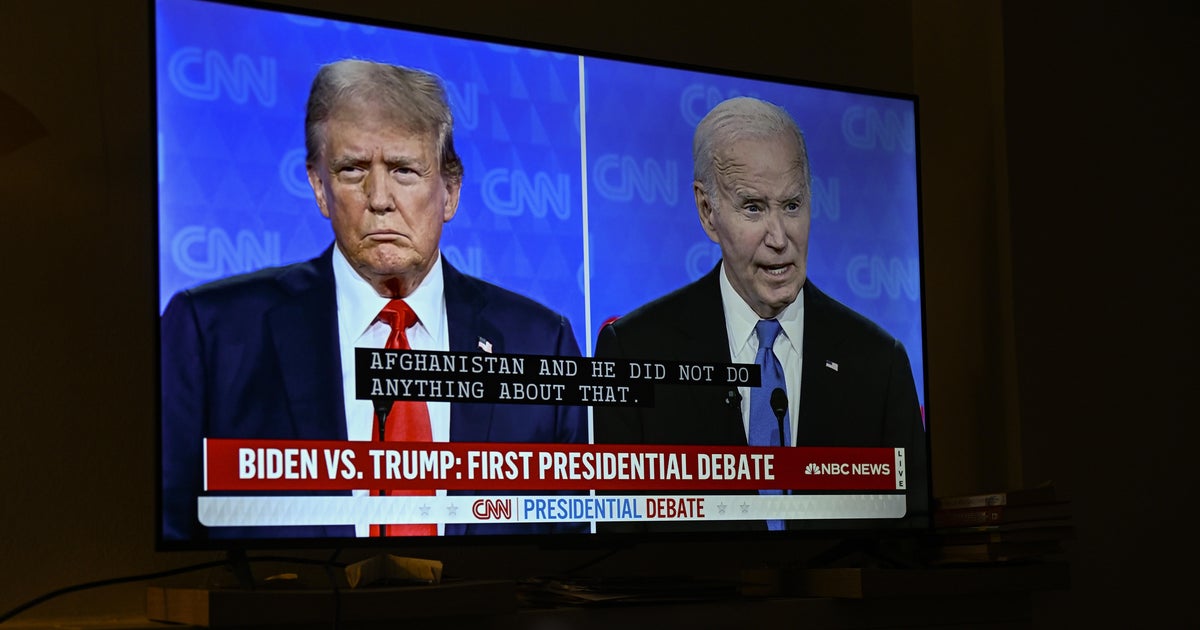World
Voting underway in Iran's presidential election following leader's death in helicopter crash
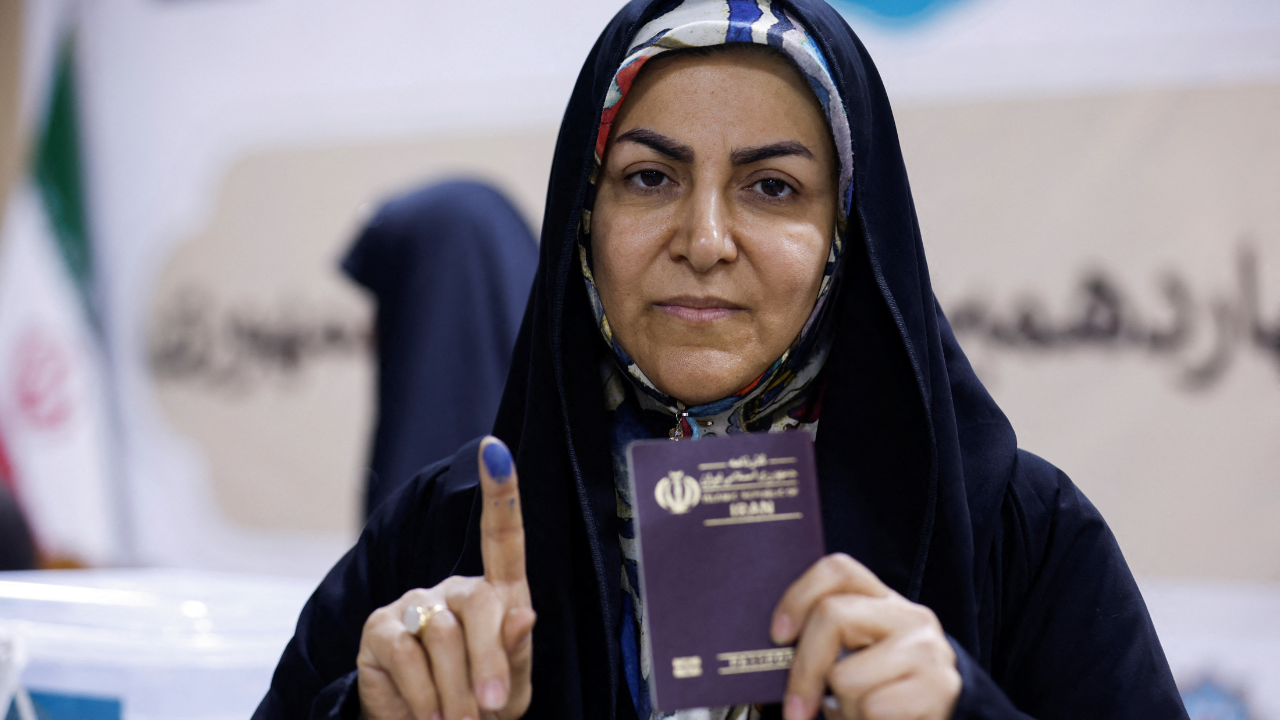
- Iranians began voting on Friday for a new president after Ebrahim Raisi’s death in a helicopter crash.
- More than 61 million Iranians were eligible to vote, with polling stations showing queues across several cities.
- Final results are expected after two days, with a potential runoff if no candidate secures a majority.
Iranians started voting on Friday for a new president following the death of Ebrahim Raisi in a helicopter crash, choosing from a tightly controlled group of four candidates loyal to the supreme leader at a time of growing public frustration.
State television showed queues inside polling stations in several cities. More than 61 million Iranians are eligible to vote. Polls were due to close at 6 p.m., but are usually extended as late as midnight.
The election coincides with escalating regional tension due to war between Israel and Iranian allies Hamas in Gaza and Hezbollah in Lebanon, as well as increased Western pressure on Iran over its fast-advancing nuclear program.
IRAN INCREASES URANIUM ENRICHED TO NEAR WEAPONS-GRADE LEVELS, SEEKS TO HAVE SANCTIONS LIFTED: WATCHDOG
While the election is unlikely to bring a major shift in the Islamic Republic’s policies, its outcome could influence the succession to Ayatollah Ali Khamenei, Iran’s 85-year-old supreme leader, in power since 1989.
A woman shows her inked finger after voting in a snap presidential election to choose a successor to Ebrahim Raisi following his death in a helicopter crash at the Iranian consulate in Najaf, Iraq, on June 28, 2024. (REUTERS/Alaa al-Marjani)
Khamenei called for a high turnout to offset a legitimacy crisis fueled by public discontent over economic hardship and curbs on political and social freedom.
“The durability, strength, dignity and reputation of the Islamic Republic depend on the presence of people,” Khamenei told state television after casting his vote. “High turnout is a definite necessity.”
Voter turnout has plunged over the past four years, as a mostly youthful population chafes at political and social curbs.
‘BUTCHER OF TEHRAN’ DEAD BUT RAISI’S LEGACY CONTINUES AS IRAN APPOINTS ACTING PRESIDENT
Manual counting of ballots means it is expected to be two days before the final result is announced, though initial figures may come out around midday on Saturday.
If no candidate wins at least 50% plus one vote from all ballots cast, including blank votes, a run-off round between the top two candidates is held on the first Friday after the election result is declared.
Three candidates are hardliners and one is a low-profile comparative moderate, backed by the reformist faction that has largely been sidelined in Iran in recent years.
Critics of Iran’s clerical rule say the low and declining turnout of recent elections shows the system’s legitimacy has eroded. Just 48% of voters participated in the 2021 election that brought Raisi to power, and turnout hit a record low of 41% in a parliamentary election three months ago.

Iranian people stand in a queue as they wait to vote at a polling station in a snap presidential election in Tehran, Iran, on June 28, 2024. (Majid Asgaripour/WANA (West Asia News Agency) via REUTERS)
The next president is not expected to usher in any major policy shift on Iran’s nuclear program or support for militia groups across the Middle East, since Khamenei calls all the shots on top state matters.
However, the president runs the government day-to-day and can influence the tone of Iran’s foreign and domestic policy.
DIVIDED VOTERS
A hardline watchdog body made up of six clerics and six jurists aligned with Khamenei vets candidates. It approved just six from an initial pool of 80. Two hardline candidates subsequently dropped out.
Prominent among the remaining hardliners are Mohammad Baqer Qalibaf, parliament speaker and former commander of the powerful Revolutionary Guards, and Saeed Jalili, a former nuclear negotiator who served for four years in Khamenei’s office.
All four candidates have vowed to revive the flagging economy, beset by mismanagement, state corruption and sanctions re-imposed since 2018, after the United States ditched Tehran’s 2015 nuclear pact with six world powers.

Iranian people stand in a queue as they wait to vote at a polling station in Tehran, Iran, on June 28, 2024. (Majid Asgaripour/WANA (West Asia News Agency) via REUTERS)
“I think Jalili is the only candidate who raised the issue of justice, fighting corruption and giving value to the poor … Most importantly he does not link Iran’s foreign policy to the nuclear deal,” said Farzan Sadjadi, a 45-year-old artist in the city of Karaj.
The sole comparative moderate, Massoud Pezeshkian, is faithful to Iran’s theocratic rule but advocates detente with the West, economic reform, social liberalization and political pluralism.
His chances hinge on reviving the enthusiasm of reform-minded voters who have largely stayed away from the polls for the last four years after previous pragmatist presidents brought little change. He could also benefit from his rivals’ failure to consolidate the hardline vote.
“I feel Pezeshkian represents both traditional and liberal thoughts,” said architect Pirouz, 45, who had decided “to boycott the vote until he learned more about Pezeshkian’s plans”.
In the past few weeks, Iranians have made wide use of the hashtag #ElectionCircus on X, with some activists at home and abroad calling for an election boycott, saying a high turnout would legitimize the Islamic Republic.

World
US Supreme Court's slow pace on immunity makes Trump trial before election unlikely

World
Bolivia grapples with aftermath of failed coup attempt as nation strives to restore stability
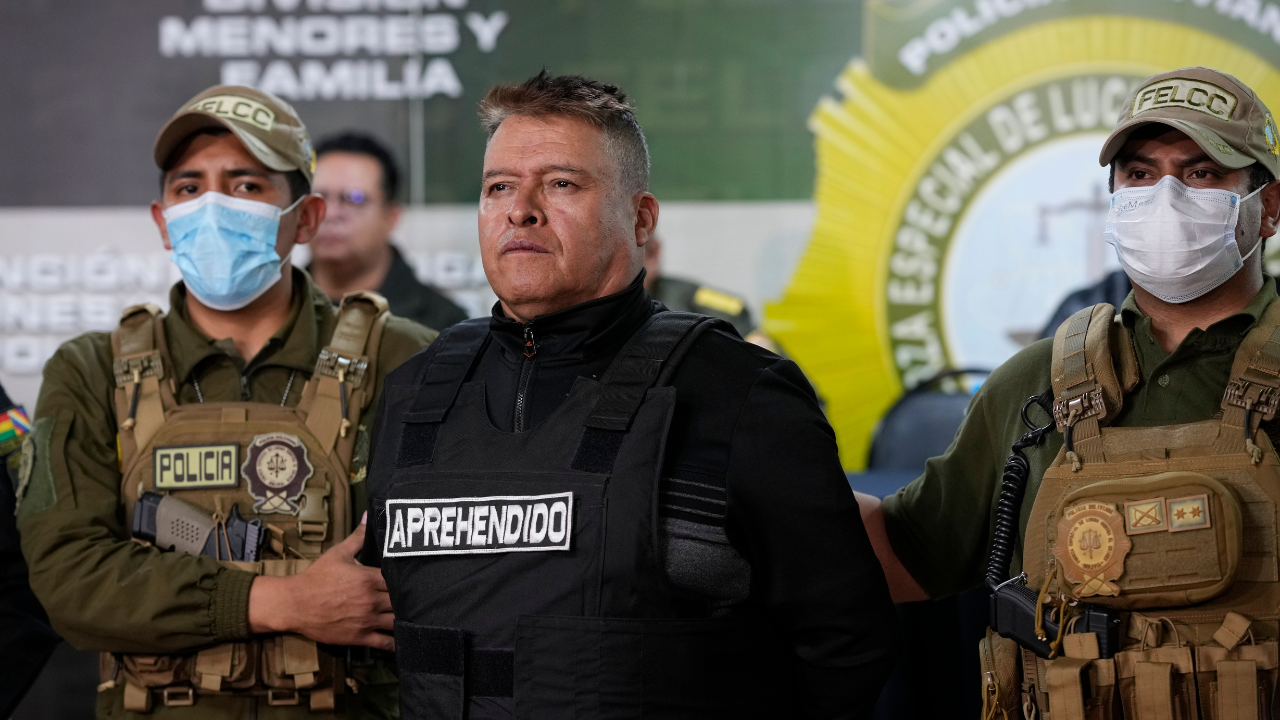
- Bolivia has been left reeling after troops, led by General Juan José Zúñiga, briefly seized the presidential palace in La Paz during an attempted coup.
- Military forces seized control of La Paz using armored vehicles and tear gas against protesters.
- Authorities arrested Zúñiga as his soldiers retreated from central La Paz.
Calm returned to Bolivia’s capital on Thursday after troops led by a top general stormed the presidential palace, then quickly retreated, tumultuous scenes that threatened to pitch the long-troubled South American democracy into chaos.
The nation of 12 million watched in shock and bewilderment Wednesday as Bolivian military forces appeared to turn on the government of President Luis Arce, seizing control of the capital’s main square with armored personnel carriers, crashing a tank into the palace and unleashing tear gas on protesters who flooded the streets.
The country’s army chief, Gen. Juan José Zúñiga, addressed a scrum of TV reporters from the palace, vowing to “restore democracy,” replace the cabinet, and free political prisoners.
BOLIVIAN PRESIDENT SURVIVES FAILED COUP, CALLS FOR ‘DEMOCRACY TO BE RESPECTED,’ ARMY GENERAL ARRESTED
But as opposition leaders condemned the apparent coup attempt, it became clear that the coup had no meaningful political support. Arce refused to relent and named a new army commander, who immediately ordered troops to stand down, ending the rebellion after just three chaotic and head-snapping hours. Hundreds of Arce’s supporters rushed the square outside the palace, waving Bolivian flags, singing the national anthem and cheering.
Bolivian police hold the detained Juan Jose Zuniga, former general commander of the Army, in La Paz, Bolivia, on June 26, 2024. Calm returned to Bolivia’s capital on Thursday after troops led by a top general stormed the presidential palace, then quickly retreated, tumultuous scenes that threatened to pitch the long-troubled South American democracy into chaos. (AP Photo/Juan Karita)
“Here we are, firm, in the presidential palace, to confront any coup attempt,” Arce said after facing down Gen. Zúñiga, calling on Bolivians to mobilize in defense of democracy.
Authorities swiftly arrested Zúñiga as his soldiers retreated from central La Paz, crushing the apparent coup attempt and defusing the latest crisis in a country wracked by a bitter political rivalry and economic crisis.
“Their goal was to overturn the democratically elected authority,” Government Minister Eduardo del Castillo told journalists in announcing the arrests of Zúñiga along with an alleged co-conspirator, former navy Vice Adm. Juan Arnez Salvador.
BOLIVIAN PRESIDENT WARNS ‘IRREGULAR’ MILITARY DEPLOYMENT UNDERWAY IN CAPITAL, RAISING COUP FEARS
The short-lived rebellion followed months of mounting tensions between Arce and his one-time ally, former President Evo Morales. Bolivia’s first Indigenous president, Morales remains a global leftist icon and towering figure in national politics years after mass protests that prompted him to resign and flee in 2019 — an ouster his supporters view as a coup.
Since returning from exile, Morales has staged a dramatic political comeback. Threatening to challenge Arce in 2025 primaries, Morales has sparked an unprecedented rift in their ruling socialist party. The feud has paralyzed efforts to resolve a spiraling economic crisis, with the country’s foreign currency reserves diminishing, its natural gas exports plummeting and its currency peg collapsing.

Police hold the detained Juan Arnez Salvador, ex-commander general of the Bolivian Navy, in La Paz, Bolivia, on June 26, 2024. (AP Photo/Juan Karita)
As police in riot gear set up blockades outside the presidential palace, Bolivians — though no stranger to political conflict in a country that has witnessed some 190 coups by one count — thronged ATMs, formed long lines outside gas stations and emptied shelves in grocery stores and pharmacies.
Flanked by the newly appointed military chiefs late Wednesday, Defense Minister Edmundo Novillo sought to reassure the rattled public and shed light on what had happened.
The turmoil began earlier this week, Novillo said, when Arce dismissed Zuñiga in a private meeting Tuesday over the army chief’s threats to arrest Morales if he proceeded with his presidential bid in 2025. In their meeting, Novillo said that Zuñiga gave officials no indication he was preparing to seize power.
“He admitted that he had committed some excesses,” Novillo said of Zuñiga. “We said goodbye in the most friendly way, with hugs. Zuñiga said that he would always be at the side of the president.”
The frantic palace takeover began hours later. Tailed by armored vehicles and supporters, Zuñiga burst into government headquarters and declared that he was sick of political infighting. “The armed forces intend to restore the democracy,” he said.
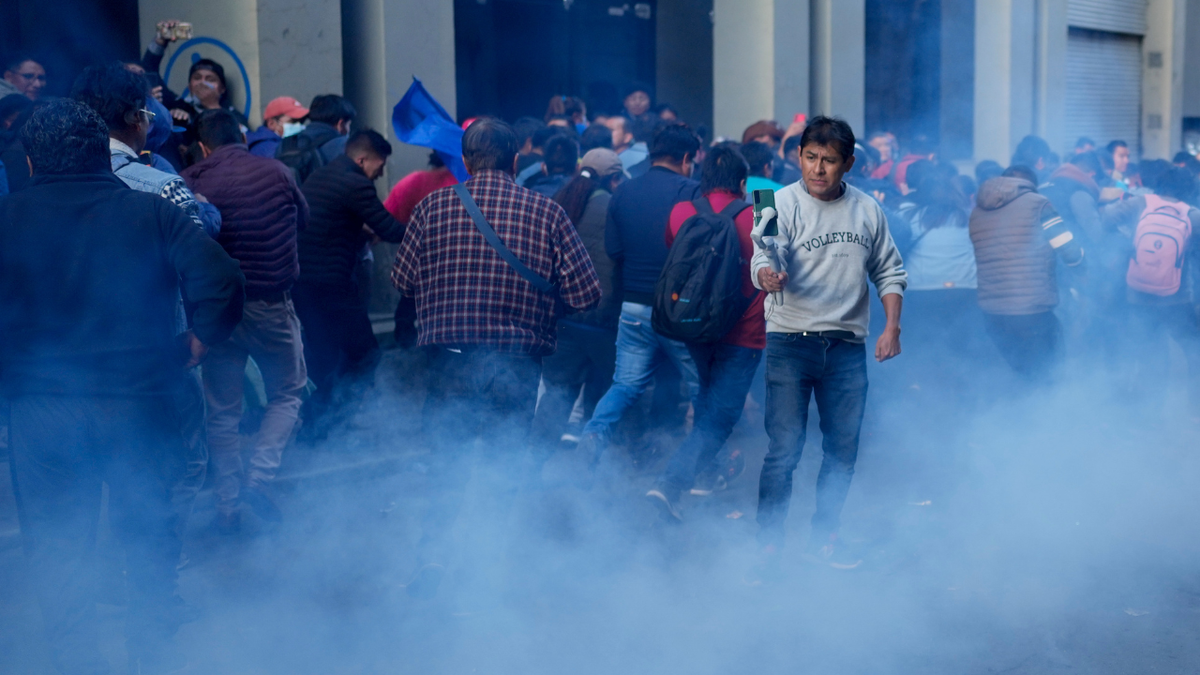
Supporters of Bolivian President Luis Arce enter Plaza Murillo amid tear gas launched by military police in La Paz, Bolivia, on June 26, 2024. (AP Photo/Juan Karita)
Members of the country’s fragmented opposition, which Zuñiga claimed to support, rejected the coup before it was clear it had failed. Former interim President Jeanine Áñez, detained for her role in Morales’ 2019 ouster, said that soldiers sought to “destroy the constitutional order” but appealed to both Arce and Morales not to run in the 2025 elections.
The mutiny by a lifelong member of the military with a low political profile stirred confusion. Just before his arrest, Zúñiga claimed that President Arce himself had asked the general to storm the palace in a ploy to boost the embattled leader’s popularity.
“The president told me: ‘The situation is very screwed up, very critical. It is necessary to prepare something to raise my popularity,’” Zúñiga quoted the Bolivian leader as saying.
Justice Minister Iván Lima denied Zúñiga’s claims, insisting the general was lying to justify his actions. Prosecutors will seek the maximum sentence of 15 to 20 years in prison for Zúñiga on charges of “attacking the constitution,” he said.
Analysts said that, more than anything, Wednesday’s events underscored the weakness of Bolivia’s democratic institutions.
“This grants control to the military and erodes democracy and is an important signpost that the problems of the 2019 coup have not been addressed,” said Kathryn Ledebur, director of the Andean Information Network, a Bolivia-based research group. “Bolivia’s democracy remains very fragile, and definitely a great deal more fragile today than it was yesterday.”
World
Caribbean braces for ‘very dangerous’ Hurricane Beryl

DEVELOPING STORYDEVELOPING STORY,
Storm begins to shut down southeast Caribbean amid urgent pleas from government officials for people to take shelter.
Much of the southeast Caribbean is on alert as Beryl strengthens into the first hurricane of the 2024 Atlantic season, with forecasters warning of a “very dangerous” Category 3 storm.
The US National Hurricane Center (NHC) said Beryl – churning in the Atlantic Ocean about 675km (420 miles) east of Barbados – at 12:30 GMT on Sunday was expected to bring “life-threatening winds and storm surge” when it reaches the Windward Islands early on Monday.
Barbados, Saint Lucia, Saint Vincent and the Grenadines, and Grenada were all under hurricane warnings, while tropical storm warnings or watches were in effect for Martinique, Tobago and Dominica, the NHC said in its latest advisory.
Cars were seen lined up at filling stations in the Barbadian capital, Bridgetown, while supermarkets and grocery stores were crowded with shoppers buying food, water and other supplies. Some households were already boarding up their properties.
Beryl is now only the third Category 3 hurricane ever recorded in the Atlantic in June, following Audrey in 1957 and Alma in 1966, according to hurricane expert Michael Lowry.
“Only five major [Category 3+] hurricanes have been recorded in the Atlantic before the first week of July. Beryl would be the sixth and earliest this far east in the tropical Atlantic,” Lowry posted on X.
‘Devastating wind damage expected’
The NHC said by about 5am (09:00 GMT) on Sunday, Beryl’s maximum sustained wind speed had increased to nearly 100mph (160kmph) with higher gusts. Such a powerful storm forming this early in the Atlantic hurricane season – which runs from early June to late November – is extremely rare, experts said.
“Hurricane conditions are expected in the hurricane warning area beginning early on Monday,” the NHC said, warning of heavy rain, flooding and storm surge that could raise water levels as much as 9 feet (2.7 metres) above normal.
“Devastating wind damage is expected where the eyewall of Beryl moves through portions of the Windward Islands,” the NHC added, indicating wind speeds in some locations could be 30 percent stronger than those listed in their advisory.
Beryl is likely to pass just south of Barbados early on Monday and then head into the Caribbean Sea as a major hurricane on a path towards Jamaica. It is expected to weaken by midweek but remain a hurricane as it heads towards Mexico.
Forecasters warned of a life-threatening storm surge in areas where Beryl will make landfall, with up to 6 inches (150mm) of rain for Barbados and nearby islands.
The US National Oceanic and Atmospheric Administration (NOAA) said in late May that it expects this year to be an “extraordinary” hurricane season, with up to seven storms of Category 3 or higher.
The agency cited warm Atlantic Ocean temperatures and conditions related to the weather phenomenon La Nina in the Pacific for the expected increase in storms.
Extreme weather events including hurricanes have become more frequent and devastating in recent years as a result of climate change.
-

 News1 week ago
News1 week agoTracking a Single Day at the National Domestic Violence Hotline
-

 World7 days ago
World7 days agoIsrael accepts bilateral meeting with EU, but with conditions
-

 World1 week ago
World1 week agoIs Israel’s Smotrich fulfilling his dream of annexing the West Bank?
-

 News1 week ago
News1 week agoSupreme Court upholds law barring domestic abusers from owning guns in major Second Amendment ruling | CNN Politics
-

 Politics1 week ago
Politics1 week agoSupreme Court upholds federal gun ban for those under domestic violence restraining orders
-

 Politics1 week ago
Politics1 week agoTrump classified docs judge to weigh alleged 'unlawful' appointment of Special Counsel Jack Smith
-

 World1 week ago
World1 week agoNew Caledonia independence activists sent to France for detention
-

 News1 week ago
News1 week agoA Florida family is suing NASA after a piece of space debris crashed through their home













